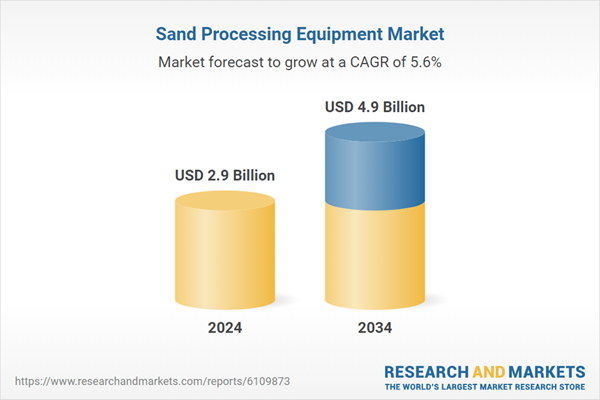Global regulatory bodies are also steering the market in a greener direction by encouraging the adoption of machinery that supports environmentally responsible practices. The equipment being developed today is designed to operate with greater precision, efficiency, and a smaller ecological footprint. To comply with stricter environmental regulations, manufacturers are designing solutions that conserve resources and enable better control over processing outcomes. These innovations are gaining traction as concerns over resource depletion and environmental damage grow stronger.
Among the equipment categories, washing systems took the lead in 2024, generating revenue of around USD 900 million. This segment is forecast to grow at a CAGR of 5.9% throughout the 2025-2034 period. The growing adoption of automated washing systems stems from their ability to deliver clean, consistent, and high-grade sand output. These machines are becoming essential for companies looking to reduce water waste, recycle process water, and maintain sand quality at scale. In addition, advanced technologies like IoT and artificial intelligence are being incorporated into washing systems to enhance their real-time performance tracking, reduce energy consumption, and lower the risk of system downtime. As industries move toward achieving greener operations, demand for such intelligent washing units is only expected to intensify.
In terms of end-use, the construction sector held the lion’s share of the market in 2024, accounting for 53% of total revenue. This segment is projected to witness a CAGR of 6% over the next decade. The continued rise in global infrastructure projects, especially in rapidly developing nations, is a key growth driver. With growing urban populations and national-level infrastructure programs in motion, construction companies are increasingly relying on advanced sand processing solutions that meet the need for high-quality output and regulatory compliance. There is a strong shift toward on-site sand preparation, which enhances project efficiency and reduces dependence on external sand suppliers. As construction standards become more stringent, the demand for high-performance equipment capable of producing premium-grade materials continues to rise.
When it comes to equipment configuration, stationary systems dominated the market in 2024 and are expected to maintain a steady CAGR of over 5.2% through 2034. These systems are primarily used in large-scale industrial environments where high-volume production and long-term reliability are critical. Stationary units offer enhanced capacity, durability, and customization, making them ideal for mining and heavy infrastructure projects. Additionally, the integration of advanced control technologies in stationary setups is helping companies optimize energy use, improve output quality, and minimize operational downtime. These innovations are particularly appealing to firms focused on reducing their carbon footprint and maintaining consistent product standards.
Regionally, the United States emerged as the top-performing market within North America in 2024, contributing nearly USD 500 million in revenue and capturing 77% of the region’s total market share. This dominance is closely linked to major public and private investments in infrastructure upgrades. As modernization efforts accelerate across the country - particularly in transportation, commercial construction, and housing - there is a noticeable increase in demand for sand processing systems that can deliver performance, compliance, and sustainability. Manufacturers are responding with modular, automation-friendly designs that meet both functional requirements and regulatory mandates. These systems are allowing companies to better align with current and upcoming environmental standards while maximizing long-term value.
Major players in the sand processing equipment industry are prioritizing strategic growth through acquisitions, partnerships, and innovation-driven investments. Many companies are enhancing their portfolios with new technologies that promise better efficiency, reduced emissions, and superior sand quality. The industry is steadily moving toward an ecosystem of integrated solutions, offering systems that support a wide range of applications while enabling companies to future-proof their operations in a sustainability-driven global market.
Comprehensive Market Analysis and Forecast
- Industry trends, key growth drivers, challenges, future opportunities, and regulatory landscape
- Competitive landscape with Porter’s Five Forces and PESTEL analysis
- Market size, segmentation, and regional forecasts
- In-depth company profiles, business strategies, financial insights, and SWOT analysis
This product will be delivered within 2-4 business days.
Table of Contents
Companies Mentioned
- Aggregates Equipment
- Astec
- CDE Group
- D&G Machinery
- FSP
- LZZG
- McLanahan
- Metso
- Mogensen
- Palmer
- Sinonine
- Sinto
- Superior Industries
- Titan Crushing Equipment
- Weir
Table Information
| Report Attribute | Details |
|---|---|
| No. of Pages | 220 |
| Published | June 2025 |
| Forecast Period | 2024 - 2034 |
| Estimated Market Value ( USD | $ 2.9 Billion |
| Forecasted Market Value ( USD | $ 4.9 Billion |
| Compound Annual Growth Rate | 5.6% |
| Regions Covered | Global |
| No. of Companies Mentioned | 15 |









